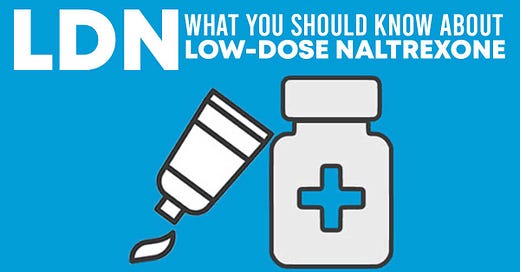FAQ Episode 6: Low Dose Naltrexone and Migraine
Frequently Asked Questions about Natural Migraine Relief for Women
Hi! Jeff Baker here again, as the physician host for Frequently Asked Questions about Natural Migraine Relief for Women. Today I’m going to tell you about a therapy option where “a lot less is sometimes a lot better.”
Naltrexone has made news for its ability to block opiate receptors and save a life in overdose situations. Naltrexone was first FDA-approved in 1984 and has been ‘off-patent’ for some time, which may explain why there is no big dollar ad budget promoting its benefits. When used in amounts that are in the 6-10% range of usual dosing it is known as “low dose naltrexone” (LDN) and can provide a range of brain regulatory activities that are separate from ‘normal dose’ opiate receptor blockage.
I don’t usually address pharmaceutical therapy directly on this site, but in this situation, low-dose naltrexone is somewhat of an orphan drug use that deserves some promotion.
LDN has been shown to inhibit the production of pro-inflammatory cytokines that can aggravate multiple disorders including migraine. LDN reduces inflammatory cellular signaling to microglia in the brain, which can enhance these cells’ ability to regulate brain development, maintain neuronal networks, and perform injury repair. LDN also enhances endorphins, the peptide hormones that function as natural painkillers. LDN can also reduce gut inflammation via the peripheral nervous system. By driving these three pathways, LDN can be a useful tool to manage chronic pain, including migraine headaches.
LDN lasts 4-5 hours in the body and is best taken at bedtime to synchronize with optimal brain repair. It develops momentum on benefit over 3-5 weeks, with maximal benefit ~10-12 weeks along. We often initially advise starting at a lower dose (1-3 mg) and advancing to a full adult beneficial dose (usually ~4-4.5 mg/dose) over the first few weeks, to allow your brain to adjust. Benefits like decreased inflammation, relief from pain, or overall symptom improvement may plateau over the following 9-12 months, and continued benefits at that time may suggest that ongoing treatment with LDN is an option.
Although rare, there can be some side effects from LDN. Usually occurring in the first 2-3 weeks of use, side effects like vivid dreams, anxiety, and dizziness can occur, and if they become bothersome or persistent you should review them with your prescribing physician. LDN can also block the intoxication ‘buzz’ of alcohol, but not the motor impairment, so it’s best to avoid alcohol in the 4–6-hour time frame after taking a dose. In general, it is best to avoid opiates, alcohol, sedatives, and tranquilizers when taking naltrexone, and this can be a problem for some people’s drug regimens for pain or anxiety. If you have an autoimmune thyroid disorder or are on thyroid medication, you should be aware that LDN could act to improve your thyroid production, so the total “what you make + what you take” total could rise above optimal levels. Possibly a good problem, if it’s monitored closely.
LDN prescriptions need to be filled at a compounding pharmacy, which can be readily found by mail order if there is not one local to you. It's possible that your own physician may not be aware of or comfortable with LDN prescribing. If you need to find a prescribing physician and can locate a local compounding pharmacist, ask them for a nearby physician who “knows what they’re doing with LDN.”
If you want to read more about LDN, I recommend “The LDN Book” by Linda Elsegood. It now has three volumes, but I would start with her original first text.
Low Dose Naltrexone is just one of many examples of how understanding the root cause factors in disease can lead us to rational therapy choices that otherwise weren’t entirely obvious.
There are many, many more options to help you find and address root causes using non-drug therapy. From my 35 years of experience in managing headaches and hormones, I’ve developed the online course Natural Migraine Relief for Women which examines in detail ten major root cause factors for migraine headaches, written specifically for women with migraines.
The Natural Migraine Relief course uses my unique Migraine Action Plan tool to help you assess the potential overlap of 60+ health conditions and medical co-morbidities. It will also direct you to which of more than 90 specific non-drug intervention options are most applicable to your migraine story. To learn more about this course, what it offers, and how to get started, browse over to naturalmigrainerelief.online
Also, remember to subscribe to this Substack blog to get regular postings on Frequently Asked Questions about Natural Migraine Relief for Women.
This blog article should not be construed as a definitive review of either migraine or naltrexone and is not intended to serve as personal medical advice for any particular reader.




